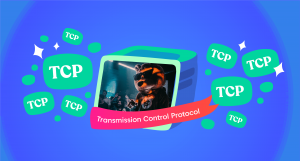When it comes to understanding how the Internet works, it is necessary to understand how data is sent and received through the internet protocol model, moreover, the difference between TCP and UDP. These are communication protocols that fulfill different functions and work better in combination to exploit the strengths of each one optimally.
UDP and TCP are both used to transfer data across a network. But they have some fundamental differences. Let’s draw the comparison of TCP vs. UDP, their features, and the advantages and disadvantages of these protocols.
What is the IP protocol?
IP stands for the acronym Internet Protocol, and its primary function is to organize the flow of Internet traffic. The IP protocol is the one that determines how a device will transmit the data through datagrams.

These datagrams present necessary information about the type of encoding of the data sent, its fragmentation, the source address, and the destination address. The source and destination addresses are encoded in 32 bits expressed in four octets and are one of the keys to the operation of the IP protocol. From the organizing role of the IP protocol, we can understand the transmission roles of the TCP and UDP protocols.
TCP and UDP are two different but complementary data transmission protocols. Once the IP protocol has determined how the message’s data will be transmitted between one device and another, the TCP and UDP protocols come into action to encrypt it and send it to the address determined by the IP protocol. This information is currently sent using the TCP protocol or the UDP protocol. Let’s see all about these protocols.
What is UDP?
UDP stands for User Datagram Protocol. It’s a connectionless internet protocol whose main function is to transmit data packets over a network. A reliable user datagram protocol is a connectionless protocol and does not require a session before transmitting data. In addition, UDP does not guarantee delivery or order of messages or provide any error-checking mechanism.

UDP is often used in streaming media applications because it can provide faster data transmission than TCP. The UDP Protocol belongs to the OSI Reference Model Transport Layer 4 Internet protocol family. It provides a simple interface between the Network Layer and the higher layers. UDP allows datagrams to be sent over the network without a previously established connection. This makes UDP a more efficient protocol than TCP for applications that do not require reliable, ordered delivery of messages.
UDP also has the advantage of requiring fewer network resources than TCP. For example, a server can be configured to listen for UDP packets on multiple ports, whereas a server must use a separate socket for each TCP connection.
The main disadvantage of UDP is that it provides no guarantees about the order in which datagrams are received or the accuracy of their contents. If errors occur during transmission, there is no way to correct them using the UDP protocol. Let’s see its functionality, features, pros, and cons to explain user datagram protocol in-depth.
Main features of UDP protocol
The main characteristics of this protocol are:
- It works offline and does not synchronize between the source and the destination.
- It works with whole packets or datagrams, not with individual bytes like TCP. An application that uses the UDP protocol exchanges information in the form of blocks of bytes so that for each block of bytes sent from the application layer to the transport layer, a UDP packet is sent.
- Not trustworthy. It does not use flow control or order packages.
- Its great advantage is that it causes little additional load on the network since it is simple and uses very simple headers.
Applications of UDP
Some applications that use UDP are:
- Domain Name System (DNS) queries
- Network Time Protocol (NTP) for time synchronization
- Simple Network Management Protocol (SNMP) for network management
- Trivial File Transfer Protocol (TFTP) to transfer files
- User Datagram Protocol (UDP) is also used in the Apple Airplay protocol.
- Used for broadcast and multicast type of network transmission.
Advantages of UDP
UDP protocol provides the following advantages:
- Higher speed than TCP for specific applications.
- Less overhead than TCP because UDP is a connectionless protocol.
- It can run over a more fantastic range of network conditions than TCP.
- Useful for applications that do not require reliable, ordered delivery of messages.
- Relatively simple compared to TCP.
Disadvantages of UDP
The main disadvantages of UDP are:
- Little error control or guarantee of data integrity.
- There is no mechanism to ensure that the source and destination ports match or acknowledge a message received.
- UDP is less reliable than TCP.
- UDP does not support multicast transmission.
- TCP provides better security features than UDP.
What is TCP?
The acronym TCP stands for Transmission Control Protocol. It’s a connection-oriented protocol, and its main function is to establish a network transmission connection between two devices before transmitting data. It guarantees that packets are delivered to the destination router with error checking to retrieve missing data.

The Transmission Control Protocol provides a communication service between an application program and the network at an intermediate level. It assures the delivery of reliable data packets when both client and server independently send packets simultaneously. TCP offers extensive error-checking mechanisms.
Features of TCP
The features of TCP are:
- It’s connection-oriented, whereas UDP is datagram oriented protocol.
- Reliable delivery via error checking and retransmission for error recovery.
- Sequenced delivery of packets.
- Flow control prevents congestion on the network by restricting the rate at which data is sent.
- Connection Management.
- Acknowledging packets.
- Congestion Control.
- Security features that provide authentication and data confidentiality through data encryption.
- TCP is a connectionless protocol that determines the sequence of packets by number to ensure their delivery is in order and without errors.
Applications of TCP
Some applications that use TCP are:
- File Transfer Protocol (FTP) for transferring files
- Hypertext Transfer Protocol (HTTPS) for secure web traffic
- Secure Shell (SSH) is used to access a Linux computer remotely.
- Transmission Control Protocol provides reliable communication for a wide variety of applications.
- TCP is the backbone protocol of the Internet.
Advantages of TCP
The advantages of TCP over UDP are:
- TCP provides reliable delivery, whereas UDP does not.
- UDP is faster than TCP for bulk data transfers, but TCP is faster for interactive applications.
- TCP has better security features than UDP.
- UDP does not support multicast transmission, while TCP does.
- TCP is more complex than UDP, but it provides better reliability and security features.
Disadvantages of TCP
The disadvantages of TCP are:
- It’s slower than UDP for specific applications.
- TCP requires more network resources than UDP.
- It can be more complex to implement than UDP.
UDP vs TCP: What is the Difference Between TCP and UDP?
Conclusion
After exploring the difference between TCP and UDP, it is clear that TCP has several advantages over UDP. Both protocols have their strengths and weaknesses, but they can work together to provide a solid network for data transmission. In general, TCP is a better choice for reliable data transmission, while UDP can be used for faster data transfers or applications that do not require reliability. It is always best to consult with an expert on which protocol will work best for your specific needs when in doubt.
Join 200,000+ streamers worldwide
With Castr, you can easily livestream videos on any platform in no time.
No Castr Branding
We do not include our branding on your videos.
No Commitment
No contracts. Cancel or change your plans anytime.
24/7 Support
Highly skilled in-house engineers ready to help.








